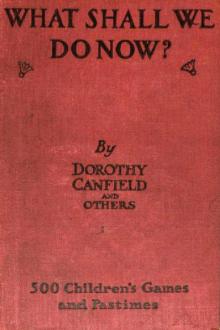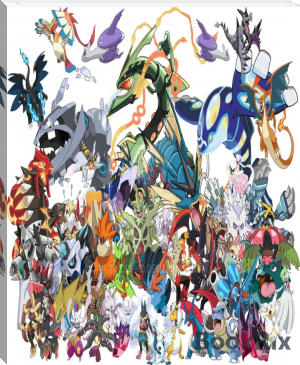What Shall We Do Now? by Dorothy Canfield Fisher (books on motivation .TXT) 📖

- Author: Dorothy Canfield Fisher
- Performer: -
Book online «What Shall We Do Now? by Dorothy Canfield Fisher (books on motivation .TXT) 📖». Author Dorothy Canfield Fisher
Snapdragon, wallflower, pansies, and hollyhocks are very easily grown from seed. They can be sown in June (wallflowers are best sown in April) in boxes, and thinned out and transplanted to permanent places as soon as they are large enough. They will blossom the following year.
SeedlingsSeedlings of most perennials can be bought for a few cents a dozen. They should be planted as quickly as possible and watered well, and they will flower the following year.
Consult a good nurseryman's catalogue for a list of hardy perennials, as for the annuals.
Bulbs—General RemarksA garden that is planted only with bulbs, or with bulbs and a few ferns, can be kept beautiful all the year round. Many of our loveliest flowers come from bulbs, and they are easy to grow and interesting to watch from the moment that the first leaf-tips push through the earth until they die down. The position of all bulbs should be very carefully marked on the beds and in your garden-plan, so that you will not cut or injure them when digging your garden over.
The first bulbs to come—through the snow sometimes—are the snowdrops, single and double, crocuses—yellow, purple, lilac, and striped—and then the tiny bright blue squills; and a little later the yellow daffodil and white narcissus, hyacinths, and tulips of every kind. Then white, red, and purple anemones, ranunculi, and wax-like Stars of Bethlehem. In June there are wonderful irises and tall spikes of summer-flowering gladiolus—red and white—and later still the tall garden lilies. There are many of these lilies, and all of them are exceedingly beautiful. Two kinds should be in all gardens—the white Madonna lily, and the orange tiger lily. All the bulbs that have been mentioned cost very little and can be grown very simply. And all bulbs that have been mentioned can remain untouched for many years unless they exhaust the soil around them (when, instead of increasing as they should each year, the plants become poorer and smaller).
Never move a bulb when it is in active growth: after the leaves have died down is the right time.
Leaf-mould mixed with your garden soil will help to give you fine flowers.
If the leaves of the bulbs are attacked by slugs, as they often are, sprinkle a little wood-ash all around them.
Planting BulbsFor planting bulbs choose a day when the earth is dry, and make your holes with a trowel. If you want to make a clump of bulb-plants, take away the earth to the right depth from the whole area you wish to fill, place your bulbs in position, points upward, and cover over, pressing the earth firmly down.
In planting a bulb in a hole made for it by a trowel, be very careful to see that it is resting on earth, and is not "hung," that is to say, kept from touching the earth underneath because of the narrowness of the hole.
All bulbs may be protected during the winter by laying hay or straw over them. This must be neatly pegged down, and removed in March.
Cutting LeavesNever cut all the leaves of plants growing from bulbs, but allow those that are unpicked to die down naturally. If they look very untidy, as the leaves of the Star of Bethlehem always do, tie them up tightly. Seeds of annuals can always be sown among bulbs, and they will hide dying leaves and fill up the places that are left vacant.
Shades"Shades" are subterranean gardens: holes in the ground, some eighteen inches deep and about a foot square (or larger), the sides of which are covered with moss and little ferns. At the bottom you can sink a pot or a tin, which must always be kept filled with water. It is more interesting if a toad or a frog lives there. Over the hole stands a shade made of glass and wood, which, together with the water, keeps it cool and moist.
Kitchen GardensIf you want to grow other things besides flowers, lettuces, radishes, and mustard and cress are interesting to raise. Strawberries, too, are easy to cultivate, but they need some patience, as the first year's growth brings very few berries. In sowing the seeds of lettuce, radish, and mustard and cress, follow directions given for sowing flower seeds on page 320. If you want to grow even the few things mentioned, which need only very simple culture, the soil of the garden must be good.
LettuceSow a few seeds of lettuce very thinly in a line once every three weeks. When the seedlings, which should be protected from birds by netting, are three inches high, thin them out, leaving one foot between each plant. The seedlings that are pulled up can be transplanted or eaten. Transplanted lettuces should be shaded during hot weather and given plenty of water. During dry and hot weather you may water lettuces every day.
RadishesSow a few radish seeds thinly once every three weeks, and cover very lightly with earth. These seedlings also must be protected by netting from birds, and must have plenty of water, or the radishes will become stringy and poor. In summer sow in a shady place.
Mustard and CressMustard and cress seed can be sown at any time and is almost sure to be successful. In very hot weather sow in the shade, or protect from the sun in the middle of the day. The cress should always be sown three days before the mustard. It is a favorite device to sow one's name in mustard and cress. For other ways of treating it, see page 332.
StrawberriesPlant strawberries carefully in August or September. Dig a hole for each plant and spread the roots well out. Hold the plant while filling in the earth, so that that part of it where root and stem join comes just below the soil. Each plant should be eighteen inches from its neighbor. Cut off all runners—that is, the long weedy stems which the plants throw out in spring, and water well if the weather is dry. Protect the strawberries from birds, and watch very carefully for slugs, which are greedy strawberry-eaters. When the fruit begins to form, lay some straw on the earth under and between the plants. This will keep the berries clean.
Town GardensSo far, we have been speaking of gardens in the country, or, at any rate, not among houses. There are many more difficulties to contend with in town gardening; there is more uncertainty, and often less reward for the greatest care, than in country gardening; but the flowers that do grow seem so sweet between dull walls and under smoky chimneys, that one can forget how much more luxuriant they could be in other circumstances.
Flowers for TownsThe following list of annuals, perennials, and bulbs which grow well in the heart of towns, though it is not complete, contains enough plants to fill a garden:—
Annuals. Perennials. Bulbs. Alyssum. Jap. Anemones Crocuses. Candytuft. Campanulas. Daffodils. Collinsia. Delphiniums. Hyacinths. Coreopsis. Flags. Madonna Lillies. Mignonette. Gaillardias. Squills. Nasturtiums. Pinks. Spanish Irises. Poppies. Sunflowers. Tulips. Sunflowers. Wallflowers. Winter Aconite.In addition to the plants mentioned above, hardy ferns grow well, and so do lilies of the valley, and stonecrops and saxifrages. Wandering Jew will also thrive, and the canary creeper grows as well in town as in the country.
In summer, geraniums, fuchsias, heliotrope—which must be well watered—pansies, lemon verbena, and scented geraniums, can be planted out.
Roses do not do very well in towns; but hardy ones will grow quite enough flowers to make the possession of them a great delight.
Indoor Gardening and Window Boxes—PrecautionsA window full of flowers and green plants makes all the difference to a room. There are always certain difficulties about growing plants in a room; but these may, however, be partly overcome. One is the great change of temperature between day and night in winter; another is the very evil effect of gas on plants; and a third is the presence of dust. The difference of temperature is met to a great extent by taking the flowers away from the window at night and putting them in the middle of the room. This is specially necessary when there is any danger of frost. If gas is burned in the room where plants are all day, it is wise at evening to take the trouble to move them into another room, for nothing injures them more. As to dust, ferns and plants which have smooth leaves should be gently sponged with warm water once a week, or else the pores will be so choked that the plants will not be able to breathe. Those plants which cannot be sponged, such as fine-leafed ferns, geraniums, etc., should be gently sprayed occasionally, or, in warm weather, placed out-of-doors during a soft shower. When a room is being cleaned, the plants should either be taken away or covered with soft paper.
The window chosen for your plants should be a sunny one and as draughtless as may be. It should not be opened unless the day is very mild. One thing to remember is that wherever the plants are they should have as much sun, as equal a temperature, and as little draught as possible.
WateringNo exact rule can be given for watering; but it should be noted that water ought never to be allowed to stand in the saucers. In winter, one good watering a week with lukewarm water, applied in the morning, will be sufficient. In spring, when the plant is more active, more water will be needed, and in summer constant attention must be given to watering. Remember, that not only the surface but the whole soil needs moistening.
Flower-PotsIn spring time, if the plants seem to have outgrown their pots, or if they are not thriving well, re-pot them in larger pots with the best earth you can get. Water well after re-potting.
Turn the plants round every day, as the sun always draws them toward it.
Indoor PlantsA list follows of suitable plants to be grown indoors. Green plants are mentioned first.
Aspidistra.—Of all green plants the aspidistra is the best to grow indoors. (This plant indeed is so hardy that it will stand not only draught but even a certain amount of gas.) Its smooth, beautiful leaves should be carefully sponged every week.
India-rubber Plant.—The india-rubber plant is a very handsome, smooth, bright-leaved plant. It should not be given too much water.
Ferns.—Several hardy ferns grow well in a window. The maidenhair is very beautiful while it lasts, but it is a poor thing the second year unless it can be put into a greenhouse and cared for.
Ivy.—Small-leaved variegated ivy will grow under almost any conditions. Its leaves should be kept clean. If grown up a small trellis it is very pretty.
Japanese Fern Balls.—In February and March one can buy Japanese fern balls. The balls have to be soaked for two or three hours in water (rainwater if possible) and then drained and hung up in a window where there is not too much sun. They should be watered three times a week. Gradually the delicate ferns will grow and unfold until the whole ball is a mass of green. In November they should be put away in a cool dark place until the following February, when they can be started again.
Miniature Trees.—Fine little trees can be grown from chestnuts, beechnuts,





Comments (0)